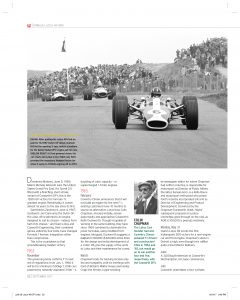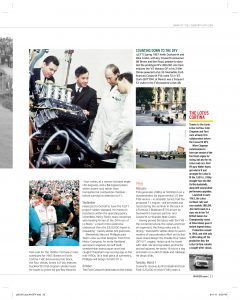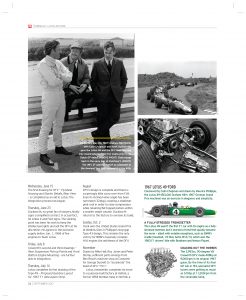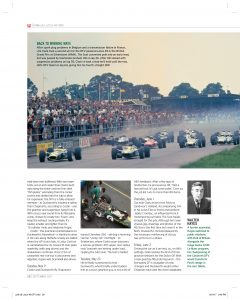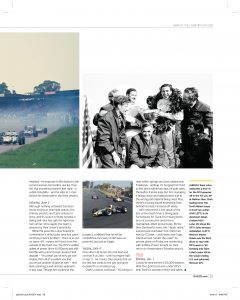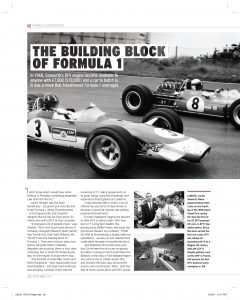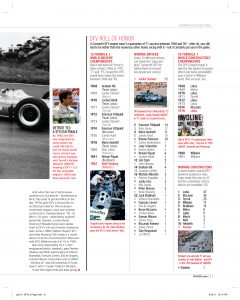Veni, DFV, Vici
Racer
September 27th 2017
Paul Fearnley
courtesy and copyright of Racer
http://www.racer.com
The best couple hundred thousand bucks ever spent in racing? That’s got to be Ford’s investment in the Cosworth DFV Formula 1 engine. Bolted to the beautifully sparse Lotus 49, it made its winning debut in the 1967 Dutch Grand Prix and never looked back.
(caption) Jim Clark had never even seen the Lotus 49 and its all-new Cosworth DFV V8 in the flesh before the combo’s winning debut in the 1967 Dutch Grand Prix. (MAIN) The Scot prepares to head out on track as the DFV’s designer, Keith Duckworth, looks on.
(caption) After putting his Lotus 49-Ford on pole for its 1967 Dutch GP debut, Graham Hill led the opening 11 laps, before a problem for the barely-tested DFV engine put him out. (BELOW RIGHT) A Ford-powered victory for Jim Clark and Lotus in the 1965 Indy 500 provided the necessary feelgood factor for when it came to FoMoCo signing off on DFV.
Downtown Motown, June 5, 1983:
Milan’s Michele Alboreto wins the United States Grand Prix East. His Tyrrell 011 fitted with a final fling, short-stroke variant of Cosworth’s DFV, this is the 155th GP victory for Formula 1’s greatest engine. Remarkably, it comes almost 16 years to the day since its first.
Sand-blown Zandvoort, June 4, 1967: Scotland’s Jim Clark wins the Dutch GP. His Lotus 49 is tailored to an engine designed to suit its chassis – indeed, form half of its chassis – and Team Lotus and Cosworth Engineering, their combined genius united by four bolts, have changed Formula 1 forever: integration rather than compromise.
This is the countdown to that groundbreaking maiden victory.
1963
November
The governing body confirms F1’s next set of regulations: from Jan. 1, 1966 it will be for (minimum) 500kg/1,110lb cars powered by naturally-aspirated 3-liter – a doubling of cubic capacity – or supercharged 1.5-liter engines.
1965
February
Coventry Climax announces that it will not build an engine for the new F1; existing customers have 10 months to source an alternative. Lotus boss Colin Chapman, shocked initially, senses opportunity and approaches Cosworth’s Keith Duckworth. Though incapable of working in the same building, they have since 1960 combined to dominate the junior formulae, using modified Ford engines. Intrigued, Duckworth suggests a ballpark £100,000 ($320,000 at the time) for the design and initial development of a 3-liter V8, plus the supply of five units
to Lotus and their maintenance for a year.
March
Chapman’s bids for backing receive only tea and sympathy until his meetings with Ford of Britain’s Walter Hayes and Harley Copp: the former, a pipe-smoking ex-newspaper editor for whom Chapman had written columns, is responsible for motorsport as Director of Public Affairs; the latter, Kansas-born, is a Rolls-Royce and motorsport enthusiast who joined Ford’s recently incorporated UK arm as Director of Engineering and Product Development. Convinced by the Chapman-Duckworth ticket, Hayes’ subsequent proposal at a policy committee goes through on the nod, as AOB: £100,000 is peanuts relatively.
Monday, May 31
Clark’s Lotus 38 scores the first Indianapolis 500 victory for a rear-engine car and Ford engine. Chapman’s stock in Detroit is high, even though he’s ruffled quite a few FoMoCo feathers.
June
A 3,000sq.ft extension to Cosworth’s Northampton, UK, base commences.
July
Cosworth undertakes a four-cylinder, twin-cam for the 1600cc Formula 2 rules scheduled for 1967. Based on Ford’s Cortina 116E five-bearing iron block, the Four Valves, Series A (FVA) features Duckworth’s first original cylinder head. He hopes to prove his gas flow theories – four valves, at a narrow included angle (40 degrees), and a flat-topped piston within a pent roof, rather than hemispherical combustion chamber – before turning his attention to F1.
September
Hayes jets to Detroit to have the F2/F1 project rubber-stamped. He meets no resistance within the operating policy committee. Henry Ford II, more concerned with beating Ferrari at the 24 Hours of Le Mans – a much more expensive endeavour than the $320,000 Hayes is requesting – merely wishes him good luck.
Meanwhile, Maurice Phillippe joins Team Lotus as chief designer from Ford Motor Company. An ex-de Havilland aerospace engineer, his self-built, stressed-skin monocoque racer had caught Chapman’s eye as long ago as the mid-1950s. (In a neat piece of symmetry, Phillippe will design Tyrrell’s 011.)
October
The Ford-Cosworth deal leaks to the media.
(caption) Counting down to the DFV. (LEFT) Spring 1967: Keith Duckworth and Mike Costin, with key Cosworth personnel Bill Brown and Ben Rood, prepare to dyno test the prototype DFV. (BELOW) Jim Clark endures the ’67 Monaco GP in his 2-liter Climax-powered Lotus 33. Meanwhile, Ford-financed Cosworth FVA ruled F2 in ’67. Clark (BOTTOM, at Reims) was a frequent F2 visitor in his FVA-powered Lotus 48.)
(sidebar: The Lotus Cortina. Thanks to the iconic Lotus Cortina, Colin Chapman and Ford were already firm collaborators before the Cosworth DFV. When Chapman commissioned a twin-cam version of the Ford Kent engine for racing, but also for his Lotus road cars, Ford PR guru Walter Hayes got wind of it and arranged for Lotus to fit the 1,557cc, 105hp straight-four into Mk1 Cortina bodyshells, along with several other performance upgrades. Launched in early 1963, the Lotus Cortina’s rally and race exploits (BELOW, Jim Clark heads to a class win in the ’64 British Saloon Car Championship round at Silverstone) gave it instant legend status. Production ceased in 1966, and with only 3,300 rolling off the production line, the Lotus Cortina remains a sought-after classic.)
1966
February
FVA generates 208hp at 9,000rpm on a dynamometer. An experimental 1.5-liter FVB version – in simplistic terms, half the proposed F1 engine – will be tested and raced during the summer in the back of a Formula 2 Brabham BT10 driven by Duckworth’s business partner and Cosworth co-founder, Mike Costin.
Having proved the basics with the FVB – the overall structure, the valves and their arrangement, the firing order and its timing – Duckworth settles down to seven months of concentrated effort on his first clean-sheet design: the Double Four Valve (DFV) F1 engine. Holed up at his home with slide rule and log tables, protractor and set squares, he works 16 hours a day and exists on a diet of steak and cabbage. He drops 40lb.
Tuesday, March 1
Cosworth receives its first instalment from Ford: £25,000 to cover FVA’s costs.
(caption) Snetterton, May 23, 1967: Graham Hill (MAIN, with Colin Chapman and Keith Duckworth) gave the Lotus 49 and the DFV their one and only meaningful test just two weeks prior to its Dutch GP debut. (ABOVE RIGHT) Clark hangs back in the early laps at Zandvoort. (RIGHT) The 49’s ZF gearbox wasn’t as adaptable as the Hewland ’box that replaced it in the 49B.)
Wednesday, June 15
The first drawing for DFV – Flywheel Housing and Starter Details, Rear View is completed as an aid to Lotus. The integration process has begun.
Thursday, June 23
Duckworth, no great fan of lawyers, finally signs a simplified contract. In actual fact, he writes it and Ford signs. The sticking point has been his wish to keep the intellectual rights and sell the DFV at his discretion. He agrees to the exclusive supply before Jan. 1, 1968 of five engines to Team Lotus.
Friday, July 8
Cosworth’s second and third drawings – Rear Suspension Pick-up Points and Front Bottom Engine Mounting – are further aids to integration.
Thursday, July 14
Lotus completes its first drawing of the Type 49 – Proposed Gearbox Layout for 1967 F1 (Discussion Only).
August
DFV’s design is complete and there is surprisingly little carry-over from FVA. Even its inclined valve angle has been narrowed (32deg), creating a shallower pent roof in order to raise compression while retaining flat-topped pistons within a smaller swept volume. Duckworth returns to the factory to oversee its build.
Sunday, Oct. 2
Clark wins the United States Grand Prix at Watkins Glen in Phillippe’s stop-gap Type 43 design. This remains the only victory for BRM’s massively complex H16 engine, the antithesis of the DFV.
November
Drawn by Mike Hall, Roy Jones and Peter Stemp, sufficient parts emerge from Ben Rood’s machine shop at Cosworth for George Duckett to “accelerate” the build of DFV “701.” Lotus, meanwhile, completes its move to a purpose-built factory at Hethel, a former WWII bomber base in Norfolk.
1967 LOTUS 49-FORD
Conceived by Colin Chapman and drawn by Maurice Phillippe, the Lotus 49 (BELOW, Graham Hill’s 1967 German Grand Prix machine) was an exercise in elegance and simplicity.
A FULLY-STRESSED TRENDSETTER
The Lotus 49 wasn’t the first F1 car with its engine as a fully-stressed member, but it started a trend that quickly became the norm – albeit with notable exceptions, such as BMW’s cradle-mounted, 1.5-liter, turbo M12/13, which won the 1983 F1 drivers’ title with Brabham and Nelson Piquet.
COAXING OUT THE HORSES
The 2,993cc, 90-degree V8 Cosworth DFV made 408hp at 9,000rpm in its original 1967 guise. By the time of its final GP win in ’83, specialist DFV tuners were getting as much as 510hp at 11,200rpm from the venerable lump.
(caption: Contrasting fortunes… (MAIN) Jim Clark celebrates a debut win for the Lotus 49 and DFV in the 1967 Dutch Grand Prix, while teammate Graham Hill (BELOW) pushes his 49 back to the pits after a timing gear failure.)
December
At last able to prioritise 49, Phillippe finalizes its front and rear suspension.
1967
Sunday, Jan. 1
Cosworth receives the bulk of Ford’s stipend: £50,000.
Thursday, Feb. 9
Team Lotus orders 49’s first parts.
Friday, Feb. 17
Fabricators Roy Franks and Colin Knight embark on 49’s build. Co-ordinated by chief mechanic Dick Scammell, they are assisted by New Zealander Leo Wybrott and new driver signing Graham Hill’s designated mechanics, Dougie Bridge and Dale Porteous – the latter another Kiwi.
Sunday, Feb. 19
Hill gives the FVA its international debut in the Warwick Farm, New South Wales, round of the New Zealand/Australiabased Tasman Series. His F2-spec Type 48 is running third when it loses drive.
Friday, March 24
The FVA wins on its European F2 debut, courtesy of Jochen Rindt’s Brabham in the Guards 100 at Snetterton, just down the road from the new Lotus factory.
March/April
The DFV runs for the first time and gives more than 400hp before a valve spring, taken from a BSA Gold Star motorcycle, breaks. Custom items by Schmitthelm in Germany will cure this problem.
Tuesday, April 25
The DFV raises eyebrows at its launch at Ford’s showroom in London’s Regent Street: the press has been expecting 12 cylinders at the mimimum… “702” is promptly shipped to Hethel for fitting.
Sunday, May 7
The 49’s scheduled debut at Monaco is missed mainly on account of the DFV’s breathing/lubrication problems. By way of a short-term fix, external aluminium tubes connecting the crankcase to the right-hand cam-box are fitted to equalize pressure.
KEITH DUCKWORTH
The Cosworth Engineering co-founder studied engineering at London’s Imperial College after completing two years of compulsory National Service with the Royal Air Force, first as a pilot, and then navigator.
Monday, May 8
Before the advent of wings and commercial liveries, 49 is a purist’s delight, Chapman and Duckworth concurring that lightness is next to godliness. The chassis, with its single piece of bodywork – a glass-fiber nose cone – is a “simple bracket” for a 90-degree V8 that is wider than it is long and butted flush to the 18-gauge aluminum monocoque’s mild-steer rear bulkhead. With two lower bolts, set an inch wider than Clark’s butt, absorbing the shear and two thin steel “fish plates” extending from the rocker covers and slotted into the tub to allow for expansion, the DFV is a fully-stressed member – at Duckworth’s insistence rather than Chapman’s, according to Costin – and the gearbox and suspension hang from it. With a buzz-saw sound from its flat-plane crank, chosen to create two “fours” and keep the exhaust routing simple, it’s neater, smaller and lighter than its 12-cylinder rivals and relatively frugal.
Costin – the practical counterbalance to Duckworth’s theoretical – is the first to drive. His runs along Hethel’s runway are halted when the AP clutch fails. A Lotus Cortina is cannibalized for its Cosworth twin-plate assembly (with peg drives) and the shakedown continues. Once 2.5in of unwanted rear toe-out is discovered and adjusted, it goes well. Scammell also drives.
(caption) Back to winning ways. After spark plug problems in Belgium and a transmission failure in France, Jim Clark took a second win for the DFV-powered Lotus 49 in the British Grand Prix at Silverstone (MAIN). The Scot converted pole into an early lead, but was passed by teammate Graham Hill on lap 26. After Hill slowed with suspension problems on lap 55, Clark re-took a lead he’d hold until the end. Hill’s DFV failed on lap 64, giving him his fourth straight DNF.
Tuesday, May 9
Costin and Duckworth fly Chapman’s loaned Cherokee 260 – skirting a hovering Harrier “Jump Jet” mid flight – to Snetterton, where Costin soon discovers a serious problem: 49’s upper rear-radius rods’ brackets are kinking under load,rippling the tub’s skin. The test is halted.
Tuesday, May 23
Hill is finally summoned to test – Duckworth, who’d briefly understudied him as Lotus’s gearbox guy, is not a fan of Hill’s feedback. After a few laps of Snetterton, he pronounces 49, “Not a bad old tool. It’s got some poke.” Even so, the job list runs to more than 80 items.
Thursday, June 1
Tax exile Clark drives from Paris to Zandvoort, Holland. Accompanying him in his Lotus Elan is friend and landlord Jabby Crombac, an influential French motorsports journalist. The Scot heads straight for the pits. Although he’s seen chassis jigs, drawings and photos of the 49, this is the first time he’s seen it in the flesh. Chassis R2, its build delayed by the necessary reinforcing of its tub, has yet to turn a wheel.
WALTER HAYES. A former journalist, Hayes switched to public relations with Ford of Britain. Alongside the mega-bucks GT40 Le Mans program, his championing of the Cosworth DFV would transform Ford’s image in the mid 1960s.
Friday, June 2
Driving the car as it arrived, i.e., on Hill’s settings, Clark tackles the first of three practice sessions for the Dutch GP. With a new gearbox fitted during lunch – the five-speed ZF is incapable of ratio changes and Duckworth would rather Chapman had used the more adaptable Hewland – he improves to fifth fastest in the second session, two-tenths quicker than Hill. But something doesn’t feel right – a subtle instability – and he slips to 1.2sec behind his teammate in the third session.
Saturday, June 3
Although nothing untoward has been found during an overnight search, the shimmy persists and Clark refuses to drive until its source is finally located: a failing ball-race has split the right-rear hub carrier. Once again, the team is amazed by their driver’s sensitivity.
While Hill gives the Lotus-Cosworth combination a debut pole, time lost spent rectifying Clark’s problem – there is as yet no spare 49 – means he’ll start from the outside of the third row. The DFV’s sudden spikes of power (from 6,500rpm) and stiff throttle with a short travel causing Clark disquiet – “You think you’ve only got one engine, then all of a sudden you find you’ve got another engine as well” – he’d been planning a wait-and-see approach in any case. Though he’s excited at the prospect, confident that he will be competitive, he’s wary of 49: twice as powerful, but just as fragile.
Sunday, June 4
Pole-sitter Hill bursts into the lead and controls it at 2sec – until his engine fails on lap 11. He coasts, then pushes the car the last few yards to the pits and gives Duckworth a consoling hug.
Clark’s caution continues – R2 being on new, softer springs and unscrubbed rear Firestones – until lap 15. Surging from third to first place within two laps, he pulls away thereafter. It looks easy, but he’s managing a failing clutch and fading brakes due to the wrong pad material being used. Plus, there’s a ticking sound emanating from behind his head. He backs off wisely.
Hill’s retirement is the result of the loss of two teeth from a timing gear. Fortuitously for Clark, his missing teeth are not consecutive and drive is maintained, albeit precariously. By the time Duckworth hears this “death rattle,” events have overtaken him: Clark has won by 23.6sec – and Hayes and Copp, who’d arrived “under the radar” by private plane on Friday, are celebrating with bottles of beer bought on their return to Amsterdam’s Schiphol airport.
(caption) (ABOVE) Team Lotus celebrates a first 1-2 for the DFV-powered 49 in the ’67 U.S. GP at Watkins Glen, Clark leading home Hill. Ford’s Walter Hayes is front-row center. (FAR LEFT) In its Zandvoort debut, Graham Hill’s Lotus 49 shows the DFV’s fully-stressed installation. (LEFT) Mexico’s Moises Solana was the third driver to race with DFV power in ’67, climbing into Team Lotus’s spare 49 for the season-ending U.S. and (pictured) Mexican GPs.
1968
Monday, Jan. 1
Cosworth receives the £25,000 balance. With four grand prix wins under DFV’s belt, Ford’s is already money well spent.
THE BUILDING BLOCK OF FORMULA 1.
In 1968, Cosworth’s DFV engine became available to anyone with £7,500 ($18,000) and a car to bolt it in. It was a move that transformed Formula 1 overnight.
(caption) (ABOVE) Jackie Stewart’s Matra passed Graham Hill’s Lotus on the fourth lap of the 1968 Dutch Grand Prix, giving the Scot the first of his 25 DFV-powered GP wins. (LEFT) Two weeks before, Bruce McLaren earned the first non-Lotus DFV win, taking his eponymous M7A to a Belgian GP victory. (BELOW LEFT) Despite glitches such as this DNF in France, Hill became the first DFV-powered world champion in ’68.
“I don’t know what I would have done without it. Probably something desperate. Like drive for Ferrari…”
Jackie Stewart was the main beneficiary – 25 grand prix victories and three Formula 1 World Championships – of Ford generosity and Cosworth integrity. But he was far from alone: 32 others won with a DFV at their shoulder.
“It changed a lot of people’s lives,” says Stewart. “And I don’t just mean drivers. It certainly changed [Stewart’s team owner] Ken Tyrrell’s life. And Frank Williams’ life. The DFV was the building block of Formula 1. They were halcyon days: new teams, full grids, better reliability. Regularly we would do three or four days of testing, two or three GP distances per day, on one engine. It would never stop.
“The breadth of what Mike Costin and Keith Duckworth – they should both have been knighted – and their team achieved was amazing. Colossal. Theirs was the university of F1. Many people went on to great things using the knowledge and experience they’d gained at Cosworth.
“I had absolute faith in them. If you’d offered me your DFV, I’d have driven it, because I knew that nobody was getting preferential treatment.”
To Colin Chapman’s chagrin, the decision to offer DFV to others after 1967 was key to F1’s long-term health. The perspicacious Walter Hayes, who’d put the precocious Stewart on a retainer – £500 ($1,400 at the time) plus a Zodiac (with red upholstery) – as early as ’64, realized Ford could either strangle or breathe life into it.
Jack Brabham, Bruce McLaren and Ken Tyrrell were the first new recipients, the latter running a French-built Matra for Stewart. In this way a Ford-badged engine won all but one of 1968’s dozen GPs, and Graham Hill and Lotus secured the drivers’ and constructors’ titles – both the first of seven consecutive with DFV power.
And when the rise of turbo power – anathema to Duckworth – threatened to kill it, the onset of ground effect in the late 1970s gave DFV a second life, its architecture ideal for the necessary underbody shapes. Lotus won another constructors’ championship in ’78 – its fifth in 10 years – while Mario Andretti joined Hill, Stewart, Jochen Rindt, Emerson Fittipaldi (twice) and James Hunt in DFV’s roll call of world champions. Alan Jones (1980), Nelson Piquet (’81) and Keke Rosberg (’82) made it a round dozen. In terms of constructors’ titles won with DFV, Williams took it to 10 in 1981.
But more importantly for F1, DFV empowered March, Hesketh, Ligier, Penske, Shadow and Wolf, and the likes of Vittorio Brambilla, François Cevert, Elio de Angelis, Gunnar Nilsson, Carlos Pace and Jo Siffert – winners all – plus the hundreds of “lucky losers” with a “Cossie” bolted in the back.
It was the engine that just kept giving.
(caption) DETROIT ’83: A STYLISH FINALE. By 1983, the DFV was outgunned by turbo power, but could still hold its own on twisty street tracks. Detroit was the perfect example, with Tyrrell’s Michele Alboreto (ABOVE) heading a DFV 1-2-3 for the venerable engine’s 155th and final grand prix win.
DFV ROLL OF HONOR
A Cosworth DFV engine wasn’t a guarantee of F1 success between 1968 and ’82 – after all, you still had to be better than the numerous other teams racing with it – but it certainly put you in the game.
12 FORMULA 1 WORLD DRIVERS’ CHAMPIONSHIPS
Had it not been for Ferrari’s three drivers’ titles in 1975, ’77 and ’79, Cosworth’s DFV would have swept the board between 1968 and ’82.
1968 Graham Hill
(Team Lotus)
1969 Jackie Stewart
(Matra)
1970 Jochen Rindt
(Team Lotus)
1971 Jackie Stewart
(Tyrrell)
1972 Emerson Fittipaldi
(Team Lotus)
1973 Jackie Stewart
(Tyrrell)
1974 Emerson Fittipaldi
(McLaren)
1976 James Hunt
(McLaren)
1978 Mario Andretti
(Team Lotus)
1980 Alan Jones
(Williams)
1981 Nelson Piquet
(Brabham)
1982 Keke Rosberg
(Williams)
(caption) Despite turbo engines being in the ascendancy by ’82, Keke Rosberg gave the DFV a final drivers’ title.
WINNING DRIVERS
Some 33 different drivers can thank the “plug and play” Cosworth DFV for taking them to at least one grand prix victory.
1 Jackie Stewart 25
(caption: DFV-powered from 1968 until his ’73 retirement, Jackie Stewart (ABOVE, in ’71) leads on Cosworth wins.)
2 Emerson Fittipaldi 14
3 Alan Jones 12
4 Mario Andretti 11
5 James Hunt 10
= Ronnie Peterson 10
7 Carlos Reutemann 7
= Jody Scheckter 7
9 Denny Hulme 6
= Nelson Piquet 6
= Jochen Rindt 6
12 Jim Clark 5
= John Watson 5
14 Graham Hill 4
15 Jacques Laffite 3
16 Michele Alboreto 2
= Patrick Depailler 2
= Jacky Ickx 2
= Niki Lauda 2
= Peter Revson 2
= Keke Rosberg 2
22 Jack Brabham 1
= Vittorio Brambilla 1
= Francois Cevert 1
= Elio de Angelis 1
= Bruce McLaren 1
= Jochen Mass 1
= Gunnar Nilsson 1
= Carlos Pace 1
= Riccardo Patrese 1
= Didier Pironi 1
= Clay Regazzoni 1
= Jo Siffert 1
10 FORMULA 1 WORLD CONSTRUCTORS’ CHAMPIONSHIPS
The DFV’s layout made it ideal for the advent of ground effect, but turbo unreliability was a factor in Williams’ early ’80s success, too.
1968 Lotus
1969 Matra
1970 Lotus
1971 Tyrrell
1972 Lotus
1973 Lotus
1974 McLaren
1978 Lotus
1980 Williams
1981 Williams
(caption) Half of DFV’s 10 constructors’ titles were with Lotus – the last in 1978 (ABOVE, Andretti and Peterson.
WINNING CONSTRUCTORS
A dozen teams scored DFVpowered grand prix wins. Lotus leads the way on 47, but the cumulative victory total is an incredible 155.
1 Lotus 47
2 McLaren 30
3 Tyrrell 23
4 Williams 17
5 Brabham 15
6 Matra 9
7 Ligier 5
8 March 3
= Wolf 3
10 Hesketh 1
= Penske 1
= Shadow 1
(caption) Penske’s one and only F1 win was courtesy of John Watson – and DFV – in the 1976 Austrian GP (ABOVE).



